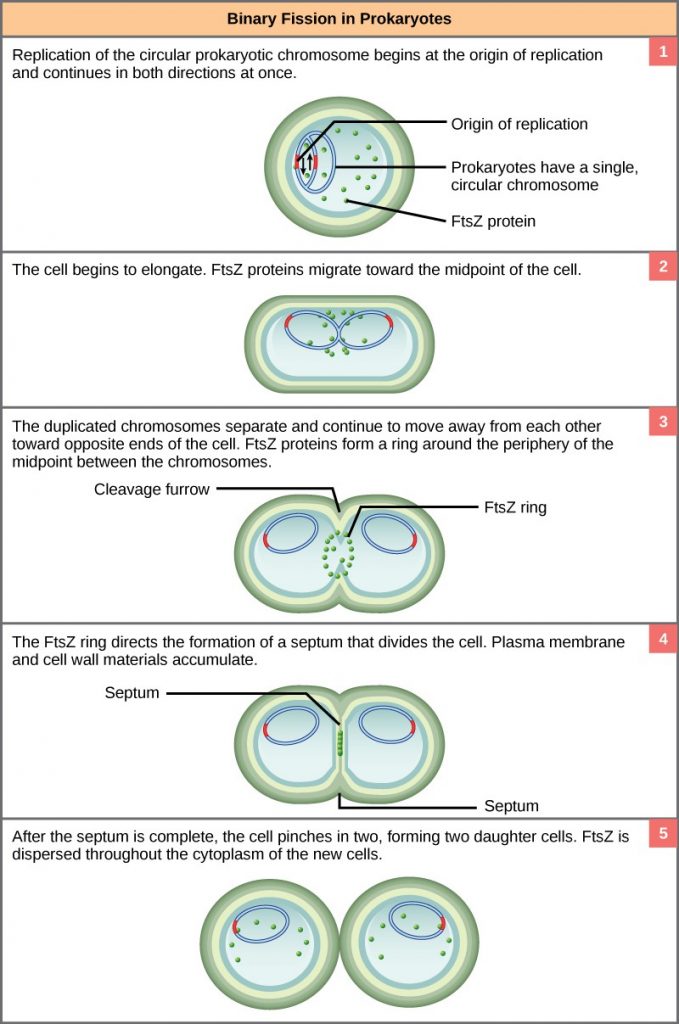Does Mitosis Occur In Prokaryotes
14 Prokaryotic Cell Sectionalisation
Past the end of this section, you lot will be able to:
- Depict the process of binary fission in prokaryotes
- Explicate how FtsZ and tubulin proteins are examples of homology
Prokaryotes such as bacteria propagate by binary fission. For unicellular organisms, cell sectionalization is the only method to produce new individuals. In both prokaryotic and eukaryotic cells, the outcome of cell reproduction is a pair of daughter cells that are genetically identical to the parent cell. In unicellular organisms, girl cells are individuals.
To achieve the outcome of identical girl cells, some steps are essential. The genomic DNA must be replicated and then allocated into the daughter cells; the cytoplasmic contents must too exist divided to requite both new cells the machinery to sustain life. In bacterial cells, the genome consists of a single, circular DNA chromosome; therefore, the process of cell division is simplified. Mitosis is unnecessary because in that location is no nucleus or multiple chromosomes. This type of cell sectionalisation is called binary fission.
Binary Fission
The cell partitioning procedure of prokaryotes, called binary fission, is a less complicated and much quicker process than jail cell division in eukaryotes. Because of the speed of bacterial prison cell segmentation, populations of leaner can grow very rapidly. The unmarried, circular Deoxyribonucleic acid chromosome of bacteria is not enclosed in a nucleus, merely instead occupies a specific location, the nucleoid, inside the prison cell. Every bit in eukaryotes, the Deoxyribonucleic acid of the nucleoid is associated with proteins that aid in packaging the molecule into a compact size. The packing proteins of bacteria are, however, related to some of the proteins involved in the chromosome compaction of eukaryotes.
The starting point of replication, the origin, is close to the binding site of the chromosome to the plasma membrane (Figure i). Replication of the Deoxyribonucleic acid is bidirectional—moving abroad from the origin on both strands of the DNA loop simultaneously. Equally the new double strands are formed, each origin signal moves abroad from the cell-wall attachment toward opposite ends of the cell. As the cell elongates, the growing membrane aids in the send of the chromosomes. Afterwards the chromosomes accept cleared the midpoint of the elongated cell, cytoplasmic separation begins. A septum is formed between the nucleoids from the periphery toward the center of the jail cell. When the new cell walls are in place, the daughter cells separate.

EVOLUTION CONNECTION
Mitotic Spindle Apparatus
The precise timing and formation of the mitotic spindle is disquisitional to the success of eukaryotic jail cell sectionalisation. Prokaryotic cells, on the other hand, do not undergo mitosis and therefore have no need for a mitotic spindle. However, the FtsZ protein that plays such a vital role in prokaryotic cytokinesis is structurally and functionally very similar to tubulin, the edifice block of the microtubules that make upwardly the mitotic spindle fibers that are necessary for eukaryotes. The formation of a ring composed of repeating units of a protein called FtsZ directs the partition between the nucleoids in prokaryotes. Formation of the FtsZ ring triggers the aggregating of other proteins that piece of work together to recruit new membrane and cell-wall materials to the site. FtsZ proteins tin course filaments, rings, and other three-dimensional structures resembling the style tubulin forms microtubules, centrioles, and various cytoskeleton components. In addition, both FtsZ and tubulin employ the aforementioned energy source, GTP (guanosine triphosphate), to rapidly assemble and detach complex structures.
FtsZ and tubulin are an instance of homology, structures derived from the same evolutionary origins. In this example, FtsZ is presumed to be similar to the antecedent protein to both the mod FtsZ and tubulin. While both proteins are found in extant organisms, tubulin function has evolved and diversified tremendously since the development from its FtsZ-like prokaryotic origin. A survey of cell-division mechanism in present-day unicellular eukaryotes reveals crucial intermediary steps to the circuitous mitotic machinery of multicellular eukaryotes (Table 1).
| Structure of genetic material | Partition of nuclear material | Separation of girl cells | |
|---|---|---|---|
| Prokaryotes | There is no nucleus. The unmarried, circular chromosome exists in a region of cytoplasm called the nucleoid. | Occurs through binary fission. Equally the chromosome is replicated, the two copies move to opposite ends of the jail cell past an unknown mechanism. | FtsZ proteins assemble into a ring that pinches the cell in 2. |
| Some protists | Linear chromosomes exist in the nucleus. | Chromosomes attach to the nuclear envelope, which remains intact. The mitotic spindle passes through the envelope and elongates the jail cell. No centrioles exist. | Microfilaments grade a cleavage furrow that pinches the cell in two. |
| Other protists | Linear chromosomes exist in the nucleus. | A mitotic spindle forms from the centrioles and passes through the nuclear membrane, which remains intact. Chromosomes attach to the mitotic spindle. The mitotic spindle separates the chromosomes and elongates the cell. | Microfilaments form a cleavage furrow that pinches the cell in two. |
| Animal cells | Linear chromosomes exist in the nucleus. | A mitotic spindle forms from the centrioles. The nuclear envelope dissolves. Chromosomes adhere to the mitotic spindle, which separates them and elongates the cell. | Microfilaments form a cleavage furrow that pinches the cell in two. |
- binary fission
- the process of prokaryotic jail cell division
- FtsZ
- a tubulin-like protein component of the prokaryotic cytoskeleton that is of import in prokaryotic cytokinesis (name origin: Filamenting temperature-sensitive mutant Z)
- origin
- the region of the prokaryotic chromosome at which replication begins
- septum
- a wall formed between bacterial daughter cells every bit a forerunner to cell separation
Admission for free at https://openstax.org/books/concepts-biology/pages/i-introduction
Does Mitosis Occur In Prokaryotes,
Source: https://pressbooks.umn.edu/introbio/chapter/mitosiscelldivision/
Posted by: velasquezchricand.blogspot.com


0 Response to "Does Mitosis Occur In Prokaryotes"
Post a Comment